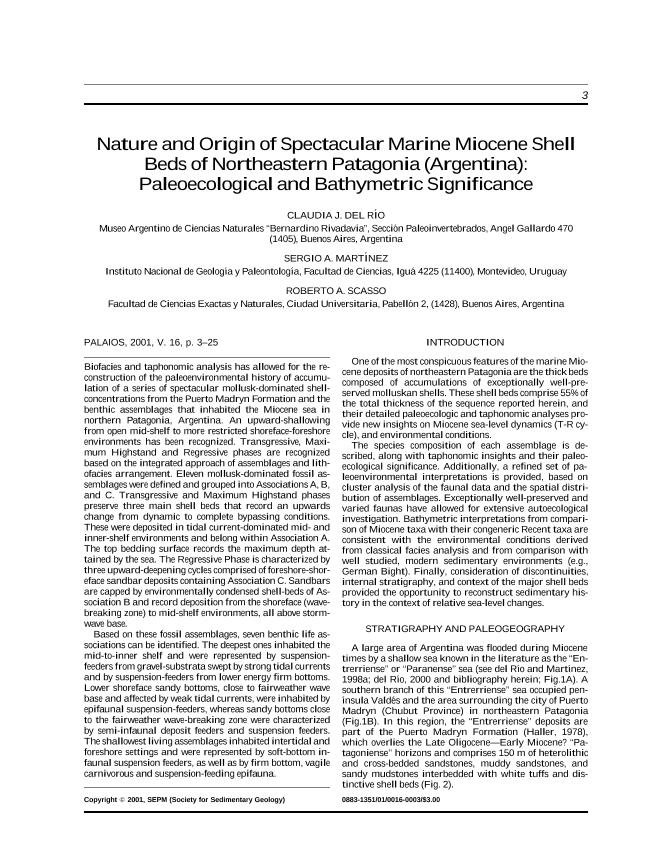Mostrar el registro sencillo del ítem
dc.contributor.author
del Río, Claudia Julia

dc.contributor.author
Martinez, Sergio A.
dc.contributor.author
Scasso, Roberto Adrian

dc.date.available
2021-07-27T13:54:54Z
dc.date.issued
2001-02
dc.identifier.citation
del Río, Claudia Julia; Martinez, Sergio A.; Scasso, Roberto Adrian; Nature and Origin of Spectacular Marine Miocene Shell Beds of Northeastern Patagonia (Argentina): Paleoecological and Bathymetric Significance; Society for Sedimentary Geology; Palaios; 16; 1; 2-2001; 3-25
dc.identifier.issn
0883-1351
dc.identifier.uri
http://hdl.handle.net/11336/137029
dc.description.abstract
Biofacies and taphonomic analysis has allowed for the reconstruction of the paleoenvironmental history of accumulation of a series of spectacular mollusk-dominated shell-concentrations from the Puerto Madryn Formation and the benthic assemblages that inhabited the Miocene sea in northern Patagonia, Argentina. An upward-shallowing from open mid-shelf to more restricted shoreface-foreshore environments has been recognized. Transgressive, Maximum Highstand and Regressive phases are recognized based on the integrated approach of assemblages and lithofacies arrangement. Eleven mollusk-dominated fossil assemblages were defined and grouped into Associations A, B, and C. Transgressive and Maximum Highstand phases preserve three main shell beds that record an upwards change from dynamic to complete bypassing conditions. These were deposited in tidal current-dominated mid- and inner-shelf environments and belong within Association A. The top bedding surface records the maximum depth attained by the sea. The Regressive Phase is characterized by three upward-deepening cycles comprised of foreshore-shoreface sandbar deposits containing Association C. Sandbars are capped by environmentally condensed shell-beds of Association B and record deposition from the shoreface (wave-breaking zone) to mid-shelf environments, all above storm-wave base. Based on these fossil assemblages, seven benthic life associations can be identified. The deepest ones inhabited the mid-to-inner shelf and were represented by suspension-feeders from gravel-substrata swept by strong tidal currents and by suspension-feeders from lower energy firm bottoms. Lower shoreface sandy bottoms, close to fairweather wave base and affected by weak tidal currents, were inhabited by epifaunal suspension-feeders, whereas sandy bottoms close to the fairweather wave-breaking zone were characterized by semi-infaunal deposit feeders and suspension feeders. The shallowest living assemblages inhabited intertidal and foreshore settings and were represented by soft-bottom infaunal suspension feeders, as well as by firm bottom, vagile carnivorous and suspension-feeding epifauna.
dc.format
application/pdf
dc.language.iso
eng
dc.publisher
Society for Sedimentary Geology

dc.rights
info:eu-repo/semantics/openAccess
dc.rights.uri
https://creativecommons.org/licenses/by-nc-sa/2.5/ar/
dc.subject
MIOCENE
dc.subject
PATAGONIA
dc.subject
ARGENTINA
dc.subject
SHELL BEDS
dc.subject.classification
Geología

dc.subject.classification
Ciencias de la Tierra y relacionadas con el Medio Ambiente

dc.subject.classification
CIENCIAS NATURALES Y EXACTAS

dc.title
Nature and Origin of Spectacular Marine Miocene Shell Beds of Northeastern Patagonia (Argentina): Paleoecological and Bathymetric Significance
dc.type
info:eu-repo/semantics/article
dc.type
info:ar-repo/semantics/artículo
dc.type
info:eu-repo/semantics/publishedVersion
dc.date.updated
2021-07-12T13:32:31Z
dc.journal.volume
16
dc.journal.number
1
dc.journal.pagination
3-25
dc.journal.pais
Estados Unidos

dc.journal.ciudad
Lawrence
dc.description.fil
Fil: del Río, Claudia Julia. Consejo Nacional de Investigaciones Científicas y Técnicas. Oficina de Coordinación Administrativa Parque Centenario. Museo Argentino de Ciencias Naturales "Bernardino Rivadavia"; Argentina
dc.description.fil
Fil: Martinez, Sergio A.. Universidad de la República; Uruguay
dc.description.fil
Fil: Scasso, Roberto Adrian. Universidad de Buenos Aires. Facultad de Ciencias Exactas y Naturales; Argentina. Consejo Nacional de Investigaciones Científicas y Técnicas; Argentina
dc.journal.title
Palaios

dc.relation.alternativeid
info:eu-repo/semantics/altIdentifier/url/https://pubs.geoscienceworld.org/sepm/palaios/article-abstract/16/1/3/99797/Nature-and-Origin-of-Spectacular-Marine-Miocene?redirectedFrom=fulltext
dc.relation.alternativeid
info:eu-repo/semantics/altIdentifier/doi/https://doi.org/10.1669/0883-1351(2001)016<0003:NAOOSM>2.0.CO;2
Archivos asociados
